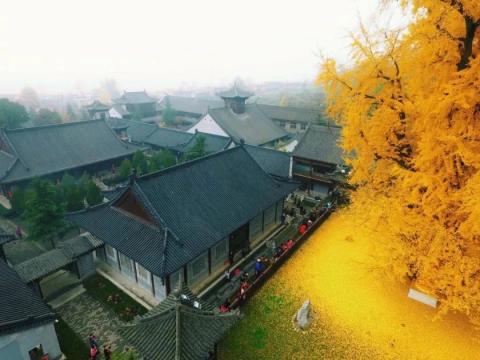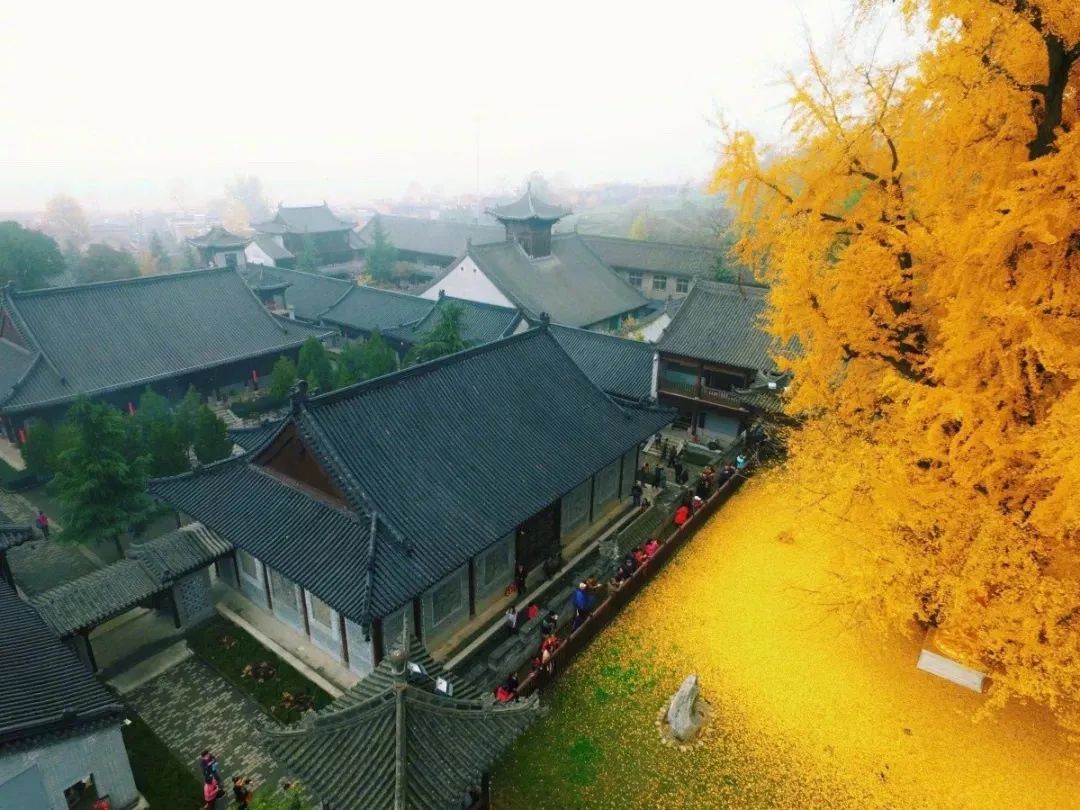
Travel notes
Impression of Chang'an
Wait until autumn comes on September 8th,
After I bloom, the flowers will be killed.
The incense towering into the sky penetrates Chang'an,
The whole city is covered with golden armor.

sequence
Here were Li Bai's romantic fantasies, Bai Juyi's youthful ambitions, too many spring breezes, and the dream of seeing all the flowers in Chang'an in one day. This is the city of miracles, and this is the city of Chang'an.
Heading for an appointment in Chang'an
Or walk slowly on the city wall and watch the collision of old buildings and high-rise buildings; or listen to Qin opera and watch shadow puppet shows and taste the unique charm of traditional skills; or make a pilgrimage to an ancient temple with a thousand-year-old ginkgo tree and dream back to the prosperous Tang Dynasty.
Traffic Guide

one
🚇Subway: Currently, 5 subway lines 1, 2, 3, 4, and Airport Line have been opened. You can get a Xi'an electronic subway card for free with Alipay and scan the code to ride.
🚌Bus: You can get the Chang'an Tong electronic card for free with Alipay and scan the QR code to take the bus.
✈️Airport: Xi'an Xianyang International Airport, directly accessible by subway.
🚞Train station: three main railway stations
Xi'an Station: Located in the urban area, the transportation is very convenient.
Xi'an North Railway Station: It is a high-speed rail station, a bit far from the city, but it is very convenient to get to the subway.
Xi'an South Railway Station: It is a very small train station, far away from the city. Try to avoid arriving at South Railway Station when traveling.
Accommodation Guide

Two
It is recommended to stay near the main city [near the Bell and Drum Tower and Big Wild Goose Pagoda]
Transportation is convenient during the day, and you can visit the ancient city at night
Big promotions at popular attractions

Three
01
Main city
–
Xi'an Ming City Wall
–
Xi'an Ming City Wall is the largest and most complete ancient city wall in China. It has a closed rectangular outline and a circumference of 13.74 kilometers. There are four main gates in the entire city wall: Changle Gate (East Gate), Yongning Gate (South Gate), Anding Gate (West Gate), and Anyuan Gate (North Gate), which together mean "Chang'an Yong'an". Since the Republic of China, 18 city gates have been opened to facilitate entry and exit. It is recommended to cycle around the city wall and feel the unique charm of ancient and modern Chang'an City on both sides.

Bell Tower and Drum Tower

In ancient times, bells were struck to announce the morning and drums were beaten to announce the evening, hence the name "morning bell and evening drum". It is located in the city center and is a landmark building in Xi'an. The two Ming Dynasty buildings echo each other and are spectacular. The Drum Tower is also the largest existing Drum Tower in China. When the lanterns start to light up, look at the Bell and Drum Tower from a distance and feel the artistic conception of the long night with the bells and drums beginning, and the stars rising into the sky.

Xi'an Forest of Steles Museum
Shaanxi History Museum

Some people say that if you want to understand a city, you must first start with its museums. Xi'an is such a city. Whether it is the Shaanxi History Museum, which condenses the essence of the Chinese nation's five thousand years of history, or the Forest of Steles Museum, a top national treasure that collects calligraphy and stone carvings, they can take you into Xi'an and travel through history.
Big Wild Goose Pagoda and Small Wild Goose Pagoda


The Big Wild Goose Pagoda was built by Xuanzang to preserve the Buddhist scriptures and statues brought back to Chang'an from Tianzhu via the Silk Road.
The Small Wild Goose Pagoda was built to store Buddhist scriptures and pictures brought back from Tianzhu by the eminent monk Yijing of the Tang Dynasty.
The two towers face each other from east to west and are two important landmarks that have been preserved to this day in Chang'an, the capital of the Tang Dynasty.

Datang Furong Garden
The Tang Dynasty Furong Garden was built on the site of the original Tang Dynasty Furong Garden, covering an area of more than 1,000 acres, including 300 acres of water area, with a total investment of 1.3 billion yuan. It is also China's first large-scale royal garden-style cultural theme that comprehensively displays the style of the prosperous Tang Dynasty. garden.
02
Eastern Front
–
Terracotta Warriors and Horses
–
Pit No. 1, No. 2 and No. 3 and Bronze Carriage and Horses (tour time is about 2.5 hours)
The Qin Terracotta Warriors not only inherited China's ceramic sculpture tradition since the Warring States Period, but also laid the foundation for the prosperity of sculpture art in the Tang Dynasty. They served as a link between the past and the future and were hailed as the "eighth wonder of the world." French President Chirac once said that he would not look at the pyramids. It doesn’t count as a real visit to Egypt, and it doesn’t count as a real visit to China if you don’t see the Qin Terracotta Warriors.

Huaqing Pool

There are 2,660 hot springs in the world, and only Huaqing ranks first. Huaqing Palace was the auxiliary palace where emperors of the Tang Dynasty visited. With the mountain on its back and the Wei River on its side, it is built against the mountain of Lifeng. The allusion about Zhou You Wangfeng playing with the princes with fire comes from Lishan Mountain. In the Tang Dynasty, Concubine Yang Guifei "washed her fat with the hot spring water" here. It also witnessed the love romance between Tang Xuanzong and Yang Guifei.
Huashan


It was called Huashan in ancient times and was known as "the most dangerous mountain in the world". It is often said that there has been one road to Mount Huashan since ancient times. Along the way, you must pass through Qianchizhuang, Baichixia, Laojun Furrow, Shangtian Ladder, Canglong Ridge and other dangerous and dangerous roads. Suggested gameplay: walk up the mountain and take the ropeway down the mountain. If you have enough time off, you can stay one night on the mountain and watch the sunrise in the morning.
03
West Line
–
Qianling
–
The tomb of Emperor Gaozong of the Tang Dynasty and Empress Wu Zetian is buried together, covering an area of more than 300,000 acres. It adopts the construction method of "making the mountain a mausoleum", and the mausoleum area imitates the structure of the capital Chang'an City. In addition to the main tomb, the Qianling Mausoleum also has 17 small accompanying tombs, where other royal members and heroes are buried. It is the best-preserved main tomb among the eighteen tombs of the Tang Dynasty, and it is also the only tomb that has not been stolen.
famen temple


Famen Temple was built in the Eastern Han Dynasty, prospered in the Northern Wei Dynasty, rose in the Sui Dynasty, and flourished in the Tang Dynasty. It is known as the "Royal Temple". It has a history of more than 1,700 years and is known as the "ancestral pagoda temple in Guanzhong". It has become a Buddhist holy place that the whole country looks up to because of the placement of the finger bone relic of Sakyamuni Buddha.
04
Northern Line
–
Hukou Waterfall
–
Hukou Waterfall is the second largest waterfall in China and the largest yellow waterfall in the world. The Yellow River flows here, with steep stone walls on both sides, and the mouth of the river is as narrow as the mouth of a Hukou, hence the name Hukou Waterfall. Due to the large drop and the fierce force of the water, Hukou Waterfall has formed four unique landscapes: smoke rising from the bottom of the water, colorful bridges reaching the sky, dragons playing in the waves, and thunder in the valley. Li Bai even wrote here that the water of the Yellow River comes up from the sky and rushes to the sea never to return. You deserve it.
Xi'an on the tip of the tongue

Four
According to incomplete statistics, there are more than 200 kinds of snacks in Xi'an. Every corner here is filled with delicacies, and the pure and traditional Chinese taste is hidden in the streets and alleys. It has also been featured in countless food programs. Among them, steamed buns are the favorite staple food of Xi'an people and the main ingredient of many snacks. Based on the steamed bun, Xi'an people have transformed it into a variety of tempting delicacies, including the fragrant meat bun, the delicious mutton steamed bun, and the artistic Guanzhong flower steamed bun, which have accompanied generations of Xi'an people. , but also a lingering taste bud memory. From Roujiamo to soup dumplings, Liangpi, mirror cakes, spicy soup, to biangbiang noodles, there are too many to mention.
Recommended food places: Huimin Street, Dapiyuan, Xiyang City, Dongmou City, Wuxing Street, Dongxin Street, Shuncheng Lane, Sajin Bridge, Yongxingfang
Xi'an Food
Dreaming back to Chang'an
Xi'an is ancient and lively. Whether it’s the city’s heritage or its food culture, everything is endlessly memorable, and the excitement of Chang’an goes beyond the Twelve Hours














